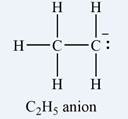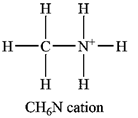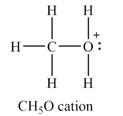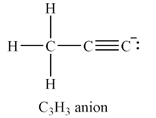
Concept explainers
(a)
Interpretation:
The Lewis structure of the
Concept introduction:
Lewis structure of a molecule or ion is drawn considering only the valence electrons of the atoms. In case of ions, for each negative charge an electron is added while for each positive charge an electron is subtracted on the ion. Each bond shows a shared pair of electrons. Single, double, and triple bonds are represented by one, two, and three lines, respectively, connecting the two atoms. Non-bonding electrons are shown as dots, generally as lone pairs. Atoms in a Lewis structure should not exceed their valency. The atoms from the 2nd row must not exceed an octet of valence electrons. Atoms from the 3rd row onward may exceed an octet by up to four electrons if they are central atoms.
The formal charge (FC) on an atom is determined as the difference between its group number and the actual number of electrons it possesses in the molecule or ion. The formula to calculate formal charge is as below.
Answer to Problem 1.50P
The Lewis structure of the

The atom that bears a non-zero formal charge is the carbon atom on the right, bonded to only two hydrogens.
Explanation of Solution
The total of valence electrons based on the formula

The formal charge on each hydrogen atom is zero:
The formal charge on the first carbon (on the left) is zero:
The formal charge on the second carbon is
Therefore, it is the carbon atom on the right, bearing only two hydrogen atoms, that has a non-zero formal charge.
The formal charge on an atom is the difference in its group number and the actual number of electrons it possesses in the molecule or ion.
(b)
Interpretation:
The Lewis structure of the
Concept introduction:
Lewis structure of a molecule or ion is drawn considering only the valence electrons of the atoms. Each bond shows a shared pair of electrons. Single, double, and triple bonds are represented by one, two, and three lines, respectively, connecting the two atoms. Non-bonding electrons are shown as dots, generally as lone pairs. Atoms in a Lewis structure should not exceed their valency. The atoms from the 2nd row must not exceed an octet of valence electrons. Atoms from the 3rd row onward may exceed an octet by up to four electrons if they are central atoms.
The formal charge on an atom is determined as the difference between its group number and the actual number of electrons it possesses in the molecule or ion. The formula to calculate formal charge is as below.
Answer to Problem 1.50P
The Lewis structure of the

The carbon atom is the one that has a non-zero formal charge.
Explanation of Solution
Carbon is the central atom in this cation, with two hydrogen atoms and the oxygen atom bonded to it. The third hydrogen atom is bonded to the oxygen as shown below:

The formal charges on the atoms are calculated as below:
Hydrogen atoms:
Carbon atom:
Oxygen atom:
An alternate structure can be drawn with all three hydrogen atoms and the oxygen atom bonded to the central carbon. However, this will put the positive charge on a highly electronegative oxygen, making it unstable. Therefore, the above mentioned structure is the most likely structure.
Therefore, the carbon atom has a non-zero formal charge.
The formal charge on an atom is the difference in its group number and the actual number of electrons it possesses in the molecule or ion.
(c)
Interpretation:
The Lewis structure of the
Concept introduction:
Lewis structure of a molecule or ion is drawn considering only the valence electrons of the atoms. Each bond shows a shared pair of electrons. Single, double, and triple bonds are represented by one, two, and three lines, respectively, connecting the two atoms. Non-bonding electrons are shown as dots, generally as lone pairs. Atoms in a Lewis structure should not exceed their valency. The atoms from the 2nd row must not exceed an octet of valence electrons. Atoms from the 3rd row onward may exceed an octet by up to four electrons if they are central atoms.
The formal charge on an atom is determined as the difference between its group number and the actual number of electrons it possesses in the molecule or ion. The formula to calculate formal charge is as below.
Answer to Problem 1.50P
The Lewis structure of the

The atom with a non-zero formal charge is the nitrogen.
Explanation of Solution
Carbon usually forms four bonds; therefore, it is a central atom. Three of the hydrogen atoms and the nitrogen atom must be bonded to it. The nitrogen atom in turn is also a central atom, with the remaining three hydrogen atoms bonded to it. Normally nitrogen forms only three bonds, but it can use its lone pair to form another bond, generally to a hydrogen ion. Therefore, the Lewis structure of the cation must be

The formal charges on the atoms are calculated as follows:
Hydrogen atoms:
Carbon atom:
Nitrogen atom:
Therefore, it is the nitrogen atom that has a non-zero formal charge.
The formal charge on an atom is the difference in its group number and the actual number of electrons it possesses in the molecule or ion.
(d)
Interpretation:
The Lewis structure of the
Concept introduction:
Lewis structure of a molecule or ion is drawn considering only the valence electrons of the atoms. Each bond shows a shared pair of electrons. Single, double, and triple bonds are represented by one, two, and three lines, respectively, connecting the two atoms. Non-bonding electrons are shown as dots, generally as lone pairs. Atoms in a Lewis structure should not exceed their valency. The atoms from the 2nd row must not exceed an octet of valence electrons. Atoms from the 3rd row onward may exceed an octet by up to four electrons if they are central atoms.
The formal charge on an atom is determined as the difference between its group number and the actual number of electrons it possesses in the molecule or ion. The formula to calculate formal charge is as below.
Answer to Problem 1.50P
The Lewis structure of

The atom with non-zero formal charge is the oxygen atom.
Explanation of Solution
The

The formal charges on the atoms are calculated as follows:
Hydrogen atoms:
Carbon atom:
Oxygen atom:
Therefore, the oxygen has a non-zero formal charge.
The formal charge on an atom is the difference in its group number and the actual number of electrons it possesses in the molecule or ion.
(e)
Interpretation:
The Lewis structure of the
Concept introduction:
Lewis structure of a molecule or ion is drawn considering only the valence electrons of the atoms. Each bond shows a shared pair of electrons. Single, double, and triple bonds are represented by one, two, and three lines, respectively, connecting the two atoms. Non-bonding electrons are shown as dots, generally as lone pairs. Atoms in a Lewis structure should not exceed their valency. The atoms from the 2nd row must not exceed an octet of valence electrons. Atoms from the 3rd row onward may exceed an octet by up to four electrons if they are central atoms.
The formal charge on an atom is determined as the difference between its group number and the actual number of electrons it possesses in the molecule or ion. The formula to calculate formal charge is as below.
Answer to Problem 1.50P
The Lewis structure of the

The carbon atom at the right end of the chain has a non-zero formal charge.
Explanation of Solution
The total of the valence electrons for this anion is
The carbon atoms have capacity to form up to four bonds. If all three hydrogen atoms are on the same carbon, this carbon must be at the end of a chain of three carbon atoms. The other two carbon atoms must be triply bonded to each other in order to complete their octets. The carbon atom at the other end of the chain must have a lone pair so that all the valence electrons are accounted for.
The Lewis structure of the

The formal charges on the atoms are calculated as follows:
Hydrogen atoms:
Carbon atom on the left and in the center of the chain:
Carbon atom at the right end of the chain:
Therefore, it is the carbon atom at the right end of the chain that has a non-zero formal charge.
The formal charge on an atom is the difference in its group number and the actual number of electrons it possesses in the molecule or ion.
Want to see more full solutions like this?
Chapter 1 Solutions
Get Ready for Organic Chemistry
- K Most Reactive Na (3 pts) Can the metal activity series (shown on the right) or a standard reduction potential table explain why potassium metal can be prepared from the reaction of molten KCI and Na metal but sodium metal is not prepared from the reaction of molten NaCl and K metal? Show how (not). Ca Mg Al с Zn Fe Sn Pb H Cu Ag Au Least Reactivearrow_forward(2 pts) Why is O2 more stable as a diatomic molecule than S2?arrow_forwardDraw the Lewis structure for the polyatomic phosphite (PO¾³¯) a anion. Be sure to include all resonance structures that satisfy the octet rule. C I A [ ]¯arrow_forward
- Decide whether these proposed Lewis structures are reasonable. proposed Lewis structure Is the proposed Lewis structure reasonable? Yes. :0: Cl C C1: 0=0: : 0 : : 0 : H C N No, it has the wrong number of valence electrons. The correct number is: ☐ No, it has the right number of valence electrons but doesn't satisfy the octet rule. The symbols of the problem atoms are:* ☐ Yes. No, it has the wrong number of valence electrons. The correct number is: ☐ No, it has the right number of valence electrons but doesn't satisfy the octet rule. The symbols of the problem atoms are:* Yes. ☐ No, it has the wrong number of valence electrons. The correct number is: ☐ No, it has the right number of valence electrons but doesn't satisfy the octet rule. The symbols of the problem atoms are:* | * If two or more atoms of the same element don't satisfy the octet rule, just enter the chemical symbol as many times as necessary. For example, if two oxygen atoms don't satisfy the octet rule, enter "0,0".arrow_forwardDraw the Lewis structure for the polyatomic trisulfide anion. Be sure to include all resonance structures that satisfy the octet rule. с [ ] - Garrow_forward1. Calculate the accurate monoisotopic mass (using all 1H, 12C, 14N, 160 and 35CI) for your product using the table in your lab manual. Don't include the Cl, since you should only have [M+H]*. Compare this to the value you see on the LC-MS printout. How much different are they? 2. There are four isotopic peaks for the [M+H]* ion at m/z 240, 241, 242 and 243. For one point of extra credit, explain what each of these is and why they are present. 3. There is a fragment ion at m/z 184. For one point of extra credit, identify this fragment and confirm by calculating the accurate monoisotopic mass. 4. The UV spectrum is also at the bottom of your printout. For one point of extra credit, look up the UV spectrum of bupropion on Google Images and compare to your spectrum. Do they match? Cite your source. 5. For most of you, there will be a second chromatographic peak whose m/z is 74 (to a round number). For one point of extra credit, see if you can identify this molecule as well and confirm by…arrow_forward
- Please draw, not just describe!arrow_forwardcan you draw each step on a piece of a paper please this is very confusing to mearrow_forward> Can the molecule on the right-hand side of this organic reaction be made in good yield from no more than two reactants, in one step, by moderately heating the reactants? esc ? A O O •If your answer is yes, then draw the reactant or reactants in the drawing area below. You can draw the reactants in any arrangement you like. • If your answer is no, check the box under the drawing area instead. olo 18 Ar Explanation Check BB Click and drag to start drawing a structure. 2025 McGraw Hill LLC. All Rights Reserved. Terms of Use | Privacy Center Accessibilityarrow_forward
- Name the structurearrow_forward> For each pair of substrates below, choose the one that will react faster in a substitution reaction, assuming that: 1. the rate of substitution doesn't depend on nucleophile concentration and 2. the products are a roughly 50/50 mixture of enantiomers. Substrate A Substrate B Faster Rate X CI (Choose one) (Choose one) CI Br Explanation Check Br (Choose one) C 2025 McGraw Hill LLC. All Rights Reserved. Terms of Use | Privacy A F10arrow_forwardHow to draw this mechanism for the foloowing reaction in the foto. thank youarrow_forward
 ChemistryChemistryISBN:9781305957404Author:Steven S. Zumdahl, Susan A. Zumdahl, Donald J. DeCostePublisher:Cengage Learning
ChemistryChemistryISBN:9781305957404Author:Steven S. Zumdahl, Susan A. Zumdahl, Donald J. DeCostePublisher:Cengage Learning ChemistryChemistryISBN:9781259911156Author:Raymond Chang Dr., Jason Overby ProfessorPublisher:McGraw-Hill Education
ChemistryChemistryISBN:9781259911156Author:Raymond Chang Dr., Jason Overby ProfessorPublisher:McGraw-Hill Education Principles of Instrumental AnalysisChemistryISBN:9781305577213Author:Douglas A. Skoog, F. James Holler, Stanley R. CrouchPublisher:Cengage Learning
Principles of Instrumental AnalysisChemistryISBN:9781305577213Author:Douglas A. Skoog, F. James Holler, Stanley R. CrouchPublisher:Cengage Learning Organic ChemistryChemistryISBN:9780078021558Author:Janice Gorzynski Smith Dr.Publisher:McGraw-Hill Education
Organic ChemistryChemistryISBN:9780078021558Author:Janice Gorzynski Smith Dr.Publisher:McGraw-Hill Education Chemistry: Principles and ReactionsChemistryISBN:9781305079373Author:William L. Masterton, Cecile N. HurleyPublisher:Cengage Learning
Chemistry: Principles and ReactionsChemistryISBN:9781305079373Author:William L. Masterton, Cecile N. HurleyPublisher:Cengage Learning Elementary Principles of Chemical Processes, Bind...ChemistryISBN:9781118431221Author:Richard M. Felder, Ronald W. Rousseau, Lisa G. BullardPublisher:WILEY
Elementary Principles of Chemical Processes, Bind...ChemistryISBN:9781118431221Author:Richard M. Felder, Ronald W. Rousseau, Lisa G. BullardPublisher:WILEY





